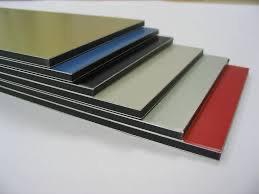 Aluminum composite panels, often referred to as ACPs, are flat panels consisting of two thin aluminum sheets bonded to a non-aluminum core. This unique composition offers a blend of lightness and strength, making ACPs a versatile material choice for various design applications.
Aluminum composite panels, often referred to as ACPs, are flat panels consisting of two thin aluminum sheets bonded to a non-aluminum core. This unique composition offers a blend of lightness and strength, making ACPs a versatile material choice for various design applications.
In interior design, this aluminum composite material excels at transforming spaces. Whether using ACPs for wall cladding, ceilings, or decor, their flexibility and durability suit both residential and commercial settings. Designers value their adaptability for seamless integration into different aesthetics.
Aesthetic Advantages of ACPs in Interior Design
Versatility in Design Options
With many colours, finishes, and textures, ACPs can imitate materials like wood or stone, giving designers the freedom to create varied looks. This versatility lets ACPs suit any design style.
Wide Range of Finishes and Textures
The surface of ACPs can be customized with finishes that vary from matte to glossy and textures that emulate natural materials. This range allows for creative freedom in achieving specific design goals.
Enhancement of Visual Appeal and Modern Aesthetics
With their sleek and polished appearance, ACPs contribute significantly to modern aesthetics. They help create clean lines and smooth surfaces, which are hallmarks of contemporary design.
Functional Benefits of ACPs in Interior Design
Durability and Longevity
Resistant to wear and tear, ACPs keep their appearance over time, making them cost-effective for high-traffic areas. Their robust nature ensures long-term performance, reducing the need for frequent replacements.
Ease of Maintenance and Cleaning
One of the practical benefits of ACPs for interior design is their low maintenance. Their surfaces resist stains and are easy to clean, needing little effort to stay pristine. This is especially beneficial in hygiene-critical areas like kitchens and bathrooms.
Weather Resistance
Though primarily used indoors, ACPs’ weather-resistant properties allow them to withstand various conditions. This makes them ideal for spaces exposed to sunlight or humidity, maintaining their integrity and aesthetics.
Lightweight Nature Facilitating Installation
ACPs’ lightweight composition simplifies installation. They are easy to handle and cut, reducing labour costs and installation time, making them attractive for designers seeking efficient solutions.
Easy to Install
Their compatibility with various installation methods makes ACPs user-friendly. Whether adhering to walls or creating partitions, their straightforward installation process is a boon for designers working under tight deadlines or budget constraints.
Environmental and Sustainability Aspects of ACPs
Recyclability and Eco-Friendly Properties
ACPs are recyclable, aligning with the growing demand for sustainable building materials. Their aluminum components can be reused, minimizing environmental impact.
Energy Efficiency and Insulation Capabilities
The structure of ACPs offers excellent insulation, enhancing energy efficiency in buildings. By maintaining temperature, they lessen dependence on heating and cooling systems.
Contribution to Green Building Standards
ACPs support compliance with green building standards by promoting sustainable design. Their recyclability and energy efficiency help designers achieve certifications like LEED.
Cost-Effectiveness and Practicality of ACPs in Interior Design
Affordability Compared to Alternative Materials
ACPs are more affordable than traditional materials like solid wood or stone. This cost-effectiveness lets designers achieve a luxurious look within budget, offering value to clients seeking economical solutions.
Reduced Installation Time and Labour Costs
The ease of handling and installing ACPs reduces labour costs and speeds up project completion. For designers, this efficiency allows quicker project turnover and the ability to take on more work within the same time.
Long-Term Cost Savings Due to Durability
Unlike materials needing frequent replacement or repair, ACPs provide lasting quality, resulting in significant long-term savings for clients.
Safety and Regulatory Aspects of ACPs in Interior Design
Fire Resistance and Safety Standards Compliance
ACPs are designed to meet stringent fire safety standards. Their fire-resistant properties make them a reliable choice for interior applications, providing peace of mind for designers and clients alike.
Health and Safety Considerations
ACPs are non-toxic and do not emit harmful gases, ensuring safe indoor air quality. This is vital in environments prioritizing occupant health, such as schools and hospitals.
Regulatory Compliance and Certifications
ACP manufacturers follow international safety and quality standards, ensuring their products meet regulatory requirements. This compliance guarantees designers the reliability and safety of ACPs in various applications.
ACPs for Cosmetic and Eco-Conscious Appeal
Aluminum composite materials like ACPs are an attractive option for interior designers balancing aesthetics, functionality, and sustainability. Their versatility encourages creativity, while durability and eco-friendliness meet practical needs.
Canada Plastics and Belting Inc. is a trusted supplier of ACPs in Toronto and the GTA. Contact us today for a free consultation!
